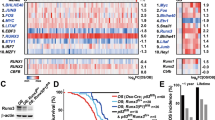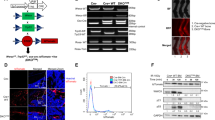Abstract
Osteosarcoma (OS) is characterized by TP53 mutations in humans. In mice, loss of p53 triggers OS development, and osteoprogenitor-specific p53-deleted mice are widely used to study the process of osteosarcomagenesis. However, the molecular mechanisms underlying the initiation or progression of OS following or parallel to p53 inactivation remain largely unknown. Here, we examined the role of transcription factors involved in adipogenesis (adipo-TFs) in p53-deficient OS and identified a novel tumor suppressive molecular mechanism mediated by C/ebpα. C/ebpα specifically interacts with Runx3, a p53 deficiency-dependent oncogene, and, in the same manner as p53, decreases the activity of the oncogenic axis of OS, Runx3-Myc, by inhibiting Runx3 DNA binding. The identification of a novel molecular role for C/ebpα in p53-deficient osteosarcomagenesis underscores the importance of the Runx-Myc oncogenic axis as a therapeutic target for OS.
This is a preview of subscription content, access via your institution
Access options
Subscribe to this journal
Receive 50 print issues and online access
$259.00 per year
only $5.18 per issue
Buy this article
- Purchase on Springer Link
- Instant access to full article PDF
Prices may be subject to local taxes which are calculated during checkout






Similar content being viewed by others
Data availability
The RNA-seq data of MSCs and mOS cells generated in this study were submitted to DDJB sequence read archive with the accession number DRA012931 and are available online.
References
Kansara M, Teng MW, Smyth MJ, Thomas DM. Translational biology of osteosarcoma. Nat Rev Cancer. 2014;14:722–35.
Chen X, Bahrami A, Pappo A, Easton J, Dalton J, Hedlund E, et al. Recurrent somatic structural variations contribute to tumorigenesis in pediatric osteosarcoma. Cell Rep. 2014;7:104–12.
Otani S, Date Y, Ueno T, Ito T, Kajikawa S, Omori K, et al. Runx3 is required for oncogenic Myc upregulation in p53-deficient osteosarcoma. Oncogene. 2022;41:683–91.
Porter DE, Holden ST, Steel CM, Cohen BB, Wallace MR, Reid R. A significant proportion of patients with osteosarcoma may belong to Li-Fraumeni cancer families. J Bone Jt Surg Br Vol. 1992;74:883–6.
Walkley CR, Qudsi R, Sankaran VG, Perry JA, Gostissa M, Roth SI, et al. Conditional mouse osteosarcoma, dependent on p53 loss and potentiated by loss of Rb, mimics the human disease. Gene Dev. 2008;22:1662–76.
Berman SD, Calo E, Landman AS, Danielian PS, Miller ES, West JC, et al. Metastatic osteosarcoma induced by inactivation of Rb and p53 in the osteoblast lineage. Proc Natl Acad Sci. 2008;105:11851–6.
Jain M, Arvanitis C, Chu K, Dewey W, Leonhardt E, Trinh M, et al. Sustained loss of a neoplastic phenotype by brief inactivation of MYC. Science. 2002;297:102–4.
Date Y, Ito K. Oncogenic RUNX3: A link between p53 deficiency and MYC dysregulation. Mol Cells. 2020;43:176–81.
Hong J-H, Hwang ES, McManus MT, Amsterdam A, Tian Y, Kalmukova R, et al. TAZ, a transcriptional modulator of mesenchymal stem cell differentiation. Science. 2005;309:1074–8.
Rosen ED, Walkey CJ, Puigserver P, Spiegelman BM. Transcriptional regulation of adipogenesis. Gene Dev. 2000;14:1293–307.
Rosen ED, MacDougald OA. Adipocyte differentiation from the inside out. Nat Rev Mol Cell Bio. 2006;7:885–96.
Wang ND, Finegold MJ, Bradley A, Ou CN, Abdelsayed SV, Wilde MD, et al. Impaired energy homeostasis in C/EBP alpha knockout mice. Sci NY. 1995;269:1108–12.
Lourenço AR, Coffer PJ. A tumor suppressor role for C/EBPα in solid tumors: more than fat and blood. Oncogene. 2017;36:5221–30.
Rubio R, Gutierrez-Aranda I, Sáez-Castillo AI, Labarga A, Rosu-Myles M, Gonzalez-Garcia S, et al. The differentiation stage of p53-Rb-deficient bone marrow mesenchymal stem cells imposes the phenotype of in vivo sarcoma development. Oncogene. 2013;32:4970–80.
Shimizu T, Ishikawa T, Sugihara E, Kuninaka S, Miyamoto T, Mabuchi Y, et al. c-MYC overexpression with loss of Ink4a/Arf transforms bone marrow stromal cells into osteosarcoma accompanied by loss of adipogenesis. Oncogene. 2010;29:5687–99.
Rodriguez R, Rubio R, Menendez P. Modeling sarcomagenesis using multipotent mesenchymal stem cells. Cell Res. 2012;22:62–77.
Hiebert SW, Lipp M, Nevins JR. E1A-dependent trans-activation of the human MYC promoter is mediated by the E2F factor. Proc Natl Acad Sci. 1989;86:3594–8.
Johansen LM, Iwama A, Lodie TA, Sasaki K, Felsher DW, Golub TR, et al. c-Myc is a critical target for c/EBPalpha in granulopoiesis. Mol Cell Biol. 2001;21:3789–806.
Iakova P, Awad SS, Timchenko NA. Aging reduces proliferative capacities of liver by switching pathways of C/EBPα growth arrest. Cell. 2003;113:495–506.
Wang H, Goode T, Iakova P, Albrecht JH, Timchenko NA. C/EBPα triggers proteasome‐dependent degradation of cdk4 during growth arrest. Embo J. 2002;21:930–41.
Wang H, Iakova P, Wilde M, Welm A, Goode T, Roesler WJ, et al. C/EBPα arrests cell proliferation through direct inhibition of Cdk2 and Cdk4. Mol Cell. 2001;8:817–28.
Ma Y, Kurtyka CA, Boyapalle S, Sung S-S, Lawrence H, Guida W, et al. A small-molecule E2F inhibitor blocks growth in a melanoma culture model. Cancer Res. 2008;68:6292–9.
Zhang DE, Hetherington CJ, Meyers S, Rhoades KL, Larson CJ, Chen HM, et al. CCAAT enhancer-binding protein (C/EBP) and AML1 (CBF alpha2) synergistically activate the macrophage colony-stimulating factor receptor promoter. Mol Cell Biol. 1996;16:1231–40.
Fujimoto T, Anderson K, Jacobsen S, Nishikawa S, Nerlov C. Cdk6 blocks myeloid differentiation by interfering with Runx1 DNA binding and Runx1‐C/EBPα interaction. Embo J. 2007;26:2361–70.
Chuang LSH, Ito K, Ito Y. RUNX family: Regulation and diversification of roles through interacting proteins. Int J Cancer. 2013;132:1260–71.
Illendula A, Gilmour J, Grembecka J, Tirumala VSS, Boulton A, Kuntimaddi A, et al. Small molecule inhibitor of CBFβ-RUNX binding for RUNX transcription factor driven cancers. Ebiomed. 2016;8:117–31.
Chen W, Zhu G, Hao L, Wu M, Ci H, Li Y-P. C/EBPα regulates osteoclast lineage commitment. Proc Natl Acad Sci. 2013;110:7294–9.
Lin PP, Pandey MK, Jin F, Raymond AK, Akiyama H, Lozano G. Targeted mutation of p53 and Rb in mesenchymal cells of the limb bud produces sarcomas in mice. Carcinogenesis. 2009;30:1789–95.
Porse BT, Pedersen TÅ, Xu X, Lindberg B, Wewer UM, Friis-Hansen L, et al. E2F repression by C/EBPα is required for adipogenesis and granulopoiesis in vivo. Cell. 2001;107:247–58.
Wurm AA, Zjablovskaja P, Kardosova M, Gerloff D, Bräuer-Hartmann D, Katzerke C, et al. Disruption of the C/EBPα—miR-182 balance impairs granulocytic differentiation. Nat Commun. 2017;8:46.
Zhao Y, Yu Z, Ma R, Zhang Y, Zhao L, Yan Y, et al. lncRNA-Xist/miR-101-3p/KLF6/C/EBPα axis promotes TAM polarization to regulate cancer cell proliferation and migration. Mol Ther Nucleic Acids. 2020;23:536–51.
Bennett KL, Hackanson B, Smith LT, Morrison CD, Lang JC, Schuller DE, et al. Tumor suppressor activity of CCAAT/enhancer binding protein α is epigenetically down-regulated in head and neck squamous cell carcinoma. Cancer Res. 2007;67:4657–64.
Seifeddine R, Dreiem A, Blanc E, Fulchignoni-Lataud M-C, Belda M-ALF, Lecuru F, et al. Hypoxia down-regulates CCAAT/enhancer binding protein-α expression in breast cancer cells. Cancer Res. 2008;68:2158–65.
Lourenço AR, Roukens MG, Seinstra D, Frederiks CL, Pals CE, Vervoort SJ, et al. C/EBPɑ is crucial determinant of epithelial maintenance by preventing epithelial-to-mesenchymal transition. Nat Commun. 2020;11:785.
Antonson P, Pray MG, Jacobsson A, Xanthopoulos KG. Myc inhibits CCAAT/enhancer‐binding protein α‐gene expression in HIB‐1B hibernoma cells through interactions with the core promoter region. Eur J Biochem. 1995;232:397–403.
He B-C, Chen L, Zuo G-W, Zhang W, Bi Y, Huang J, et al. Synergistic antitumor effect of the activated PPARγ and retinoid receptors on human osteosarcoma. Clin Cancer Res. 2010;16:2235–45.
Jeon MJ, Kim JA, Kwon SH, Kim SW, Park KS, Park S-W, et al. Activation of peroxisome proliferator-activated receptor-γ inhibits the Runx2-mediated transcription of osteocalcin in osteoblasts*. J Biol Chem. 2003;278:23270–7.
Martin JW, Zielenska M, Stein GS, van Wijnen AJ, Squire JA. The role of RUNX2 in osteosarcoma oncogenesis. Sarcoma. 2010;2011:282745.
Shin MH, He Y, Marrogi E, Piperdi S, Ren L, Khanna C, et al. A RUNX2-mediated epigenetic regulation of the survival of p53 defective cancer cells. Plos Genet. 2016;12:e1005884.
Gutierrez S, Javed A, Tennant DK, Rees M, van, Montecino M, Stein GS, et al. CCAAT/enhancer-binding proteins (C/EBP) β and δ activate osteocalcin gene transcription and synergize with Runx2 at the C/EBP element to regulate bone-specific expression*. J Biol Chem. 2002;277:1316–23.
Puig-Kröger A, Sánchez-Elsner T, Ruiz N, Andreu EJ, Prosper F, Jensen UB, et al. RUNX/AML and C/EBP factors regulate CD11a integrin expression in myeloid cells through overlapping regulatory elements. Blood. 2003;102:3252–61.
Date Y, Taniuchi I, Ito K. Oncogenic Runx1–Myc axis in p53-deficient thymic lymphoma. Gene. 2022;819:146234.
Jonkers J, Meuwissen R, van der Gulden H, Peterse H, van der Valk M, Berns A. Synergistic tumor suppressor activity of BRCA2 and p53 in a conditional mouse model for breast cancer. Nat Genet. 2001;29:418–25.
Naoe Y, Setoguchi R, Akiyama K, Muroi S, Kuroda M, Hatam F, et al. Repression of interleukin-4 in T helper type 1 cells by Runx/Cbfβ binding to the Il4 silencer. J Exp Med. 2007;204:1749–55.
de Alboran IM, O’Hagan RC, Gärtner F, Malynn B, Davidson L, Rickert R, et al. Analysis of C-MYC function in normal cells via conditional gene-targeted mutation. Immunity. 2001;14:45–55.
Sanjana NE, Shalem O, Zhang F. Improved vectors and genome-wide libraries for CRISPR screening. Nat Methods. 2014;11:783–4.
Acknowledgements
We thank I. Taniuchi, A. Berns, and F. W. Alt for providing the Runx3, p53, and Myc flox mouse lines, respectively, and all members of the Biomedical Research Center, Nagasaki University for maintaining mouse lines. This work was supported by KAKENHI/Japan Society for the Promotion of Science (JSPS) grants 18H02972 (KI), 19K22724 (K.I), and 21H03113 (KI), and by the Funding Program for Next Generation World-Leading Researchers LS097 (KI).
Author information
Authors and Affiliations
Contributions
KO and KI initiated the study. KI designed the experiments. KO, SO, YD, TU, TI, and KI conducted the experiments. YD performed bioinformatic analyses. SO and KI wrote the manuscript. MU coordinated the project. KI supervised the study.
Corresponding author
Ethics declarations
Competing interests
The authors declare no competing interests.
Additional information
Publisher’s note Springer Nature remains neutral with regard to jurisdictional claims in published maps and institutional affiliations.
Supplementary information
Rights and permissions
Springer Nature or its licensor (e.g. a society or other partner) holds exclusive rights to this article under a publishing agreement with the author(s) or other rightsholder(s); author self-archiving of the accepted manuscript version of this article is solely governed by the terms of such publishing agreement and applicable law.
About this article
Cite this article
Omori, K., Otani, S., Date, Y. et al. C/ebpα represses the oncogenic Runx3–Myc axis in p53-deficient osteosarcoma development. Oncogene 42, 2485–2494 (2023). https://doi.org/10.1038/s41388-023-02761-z
Received:
Revised:
Accepted:
Published:
Issue Date:
DOI: https://doi.org/10.1038/s41388-023-02761-z



